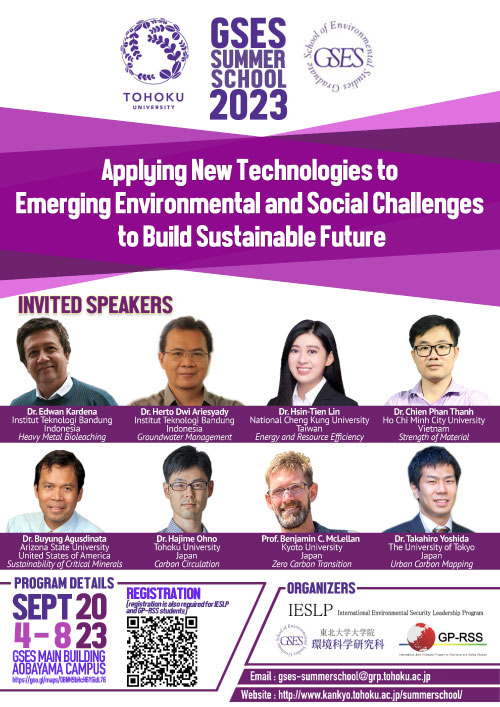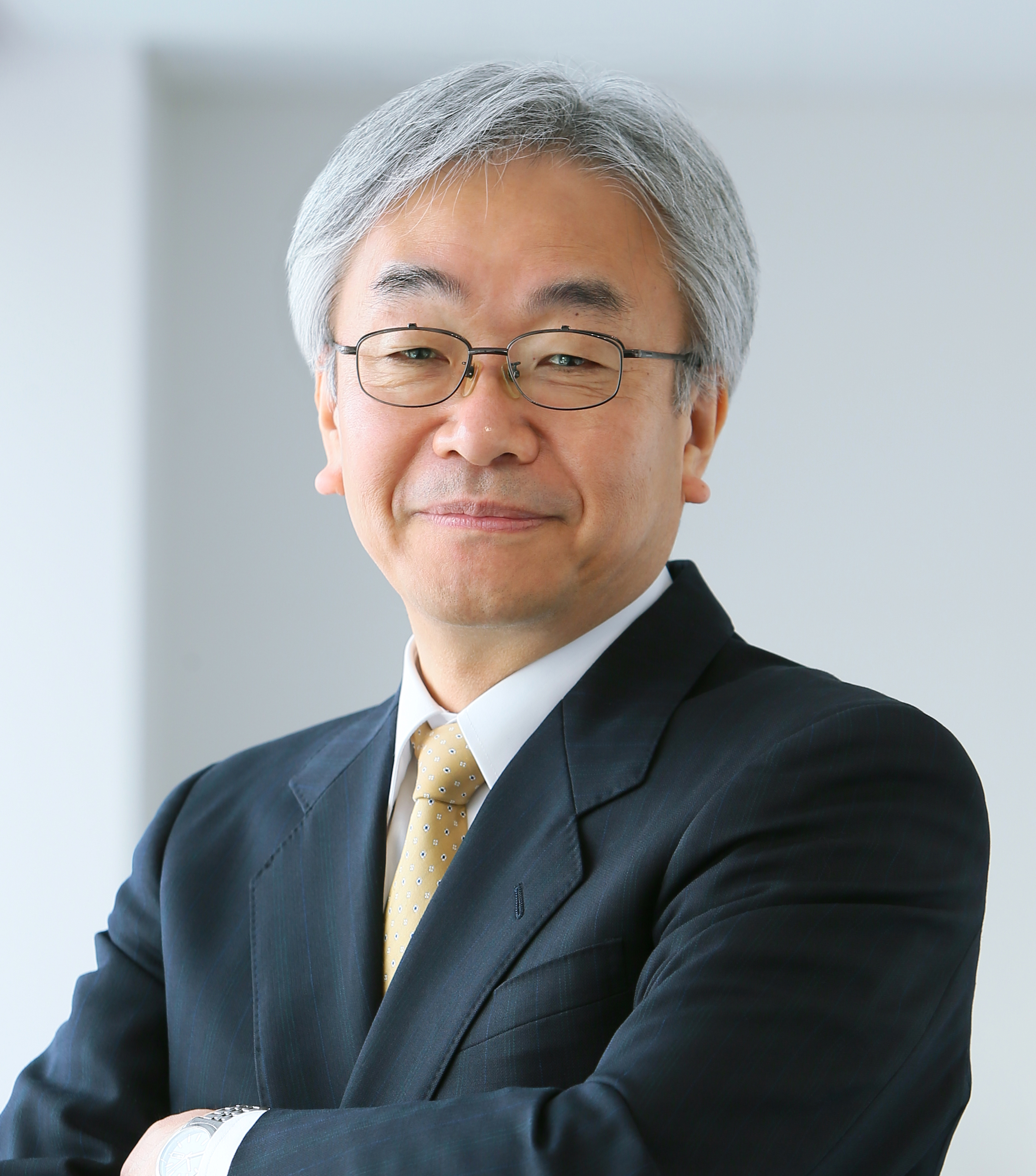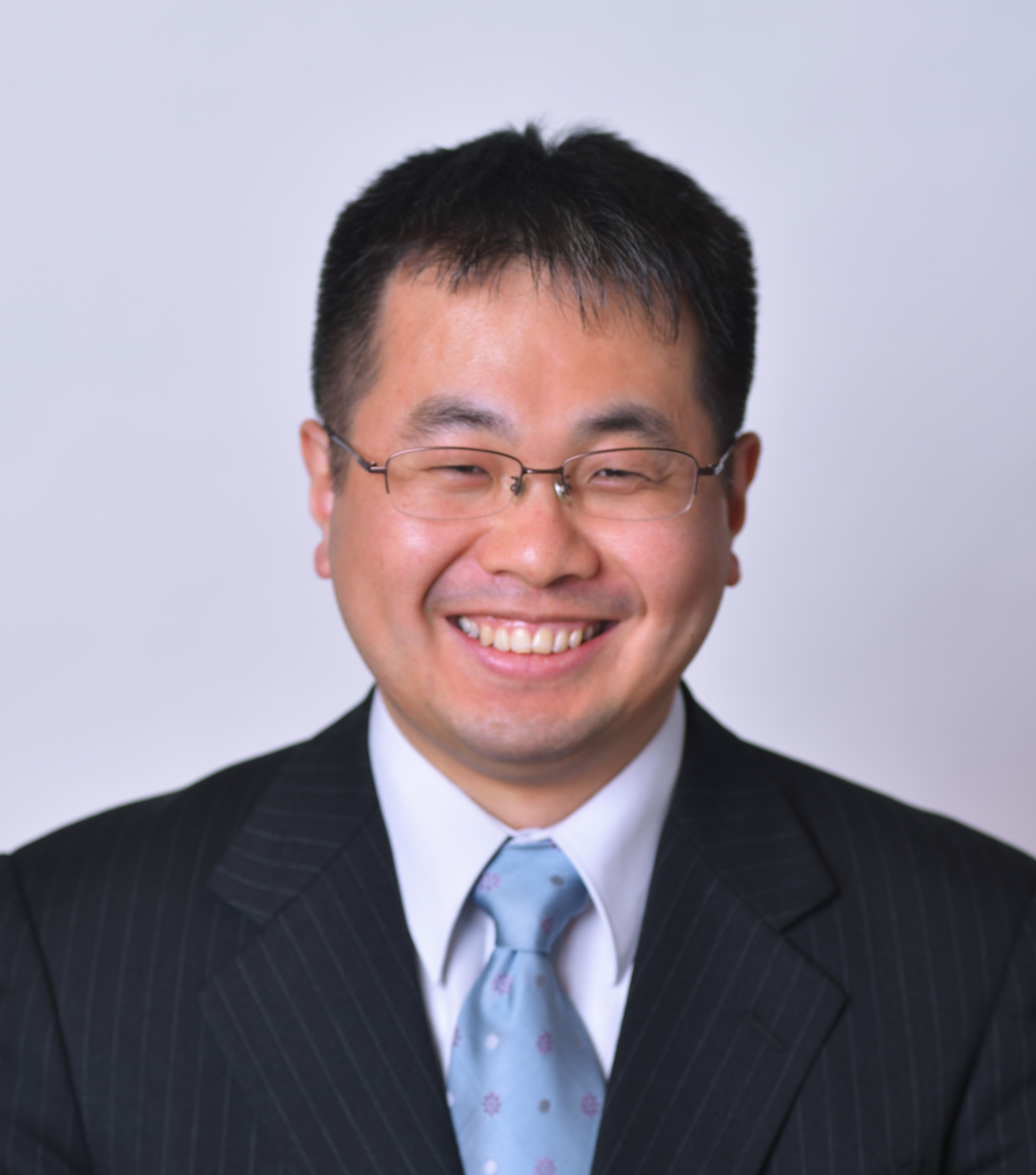GSES SUMMER SCHOOL 2023
Applying New Technologies to Emerging Environmental and Social Challenges to Build Sustainable Future
September 4 – 8, 2023
Program
September 4 (Monday)
08:30-09:00
- Registration
09:00-09:15
- Opening remarks
- Tatsuya KAWADA (Dean, Professor, GSES, Tohoku University, Japan)
09:15-10:30
- Guest Speaker 1
-
- Edwan KARDENA (Dean, Institut Teknologi Bandung, Indonesia)
"Heavy Metal Bioleaching of Coal Fly Ash by Indigenous Indonesian Origin Bacteria"
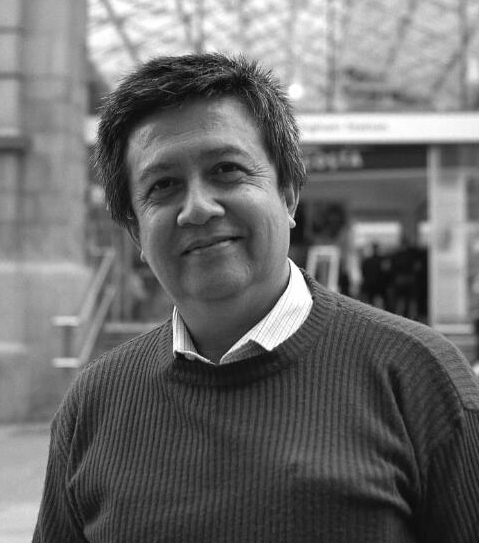
-
Bacteria are widely used in the bioremediation of contaminated environments. Indigenous bacteria are a promising agent for bioremediation. Bioleaching is one of the bioremediation methods which uses microorganisms to remove heavy metals from waste. Exploring indigenous bacteria from contaminated environments was done to get a promising bacterium for heavy metals bioleaching. Therefore, this study aims to obtain some indigenous bacteria and analysis their potential in the heavy metal bioleaching of coal fly ash. Bacteria Isolates were screened by observing their growth in culture media with fly ash. The chosen bacteria isolates were identified. The potential of bacteria in heavy metal bioleaching was studied in the variation of pulp density 5%, 10%, and 20% (w/v), bacteria were incubated and shaken at 140 rpm. The bioleaching efficiency of Cu, Zn, Cr, and Ni at the end of the process was analyzed using Atomic absorption spectroscopy. The population of bacteria, exopolysaccharide, concentration of Fe (II), pH, and temperature were observed. The results of this study are bacteria in a composite sample from a coal ash dumping site are diverse. The results of isolation and identification of bacteria are four isolates were identified as Brucella lupini, Bacillus toyonensis, Acinetobacter pittii, and Bacillus tropicus. The initial activity of such bacteria in bioleaching of heavy metal from coal ash were demonstrated.
-
- Herto ARIESYADI (Associate Professor, Institut Teknologi Bandung, Indonesia)
"Challenges of Sustainable Groundwater Management in Indonesia: A Baseline Feature for Its Restoration"
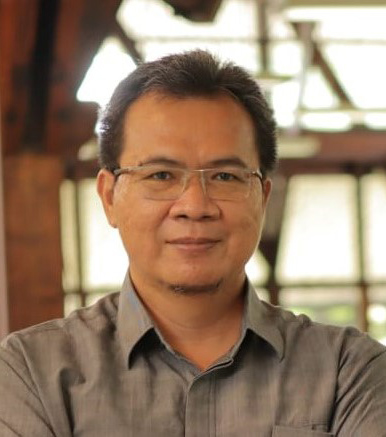
-
In many countries, groundwater is of vital importance for the livelihood and health of the people since it is often the main source for domestic water. It is also widely used for irrigated agriculture and industry. This is particularly true in dry regions where surface water is scarce or seasonal, and in rural areas with dispersed populations. Climate change is likely to lead to a greater dependence on groundwater as a cushion against drought and increasing uncertainty in surface water availability.
There is widespread recognition that water resources, including groundwater, are coming under pressure from increasing demand and declining yields. Water supply systems have often been developed in an unsustainable way, threatening vital social and economic developments. Currently, the groundwater usage, the dominant approach of provision of clean water in most cities in Indonesia, is not sustainable way and it is often unsafe in term of its quality. Therefore, an integrated approach must be tackled properly in order to prevent an escalated environmental disaster in the future.
11:00-12:30
- Open discussion with Assoc. Prof. Kardena and Assoc. Prof. Ariesyadi
13:30-15:00
- Guest speaker 2
- Hsin-Tien LIN (Assistant Professor, National Cheng Kung University, Taiwan)
"Energy and Resource Efficiency from Environmental Management Approach"

-
The rapid urbanization and social development is causing mass consumption of energy and resources. Improving the energy and resources efficiency has becoming a crucial issue nowadays. In this talk, Dr. Hsin-Tien Lin will share her experiences on promoting energy and resource efficiency by environmental management approach, including life cycle assessment, material flow analysis. She will also share how her group collaborate with industries to apply these knowledges and to promote sustainable development.
15:00-16:00
- Open discussion with Assist. Prof. Lin
September 5 (Tuesday)
- 1-day field work to Akita city:
(tentative) Mining Museum(Faculty of Engineering and Resource Scieince, Akita University), Akita Zinc Co., Ltd.
September 6 (Wednesday)
- Free work day, co-research meeting, etc.
September 7 (Thursday)
09:00-10:30
- Guest speaker 3
- PHAN Thanh Chien (Lecturer, Ho Chi Minh City University of Technology and Education, Vietnam)
"Interface Shear Strength Behavior of Cement Treated Soil"
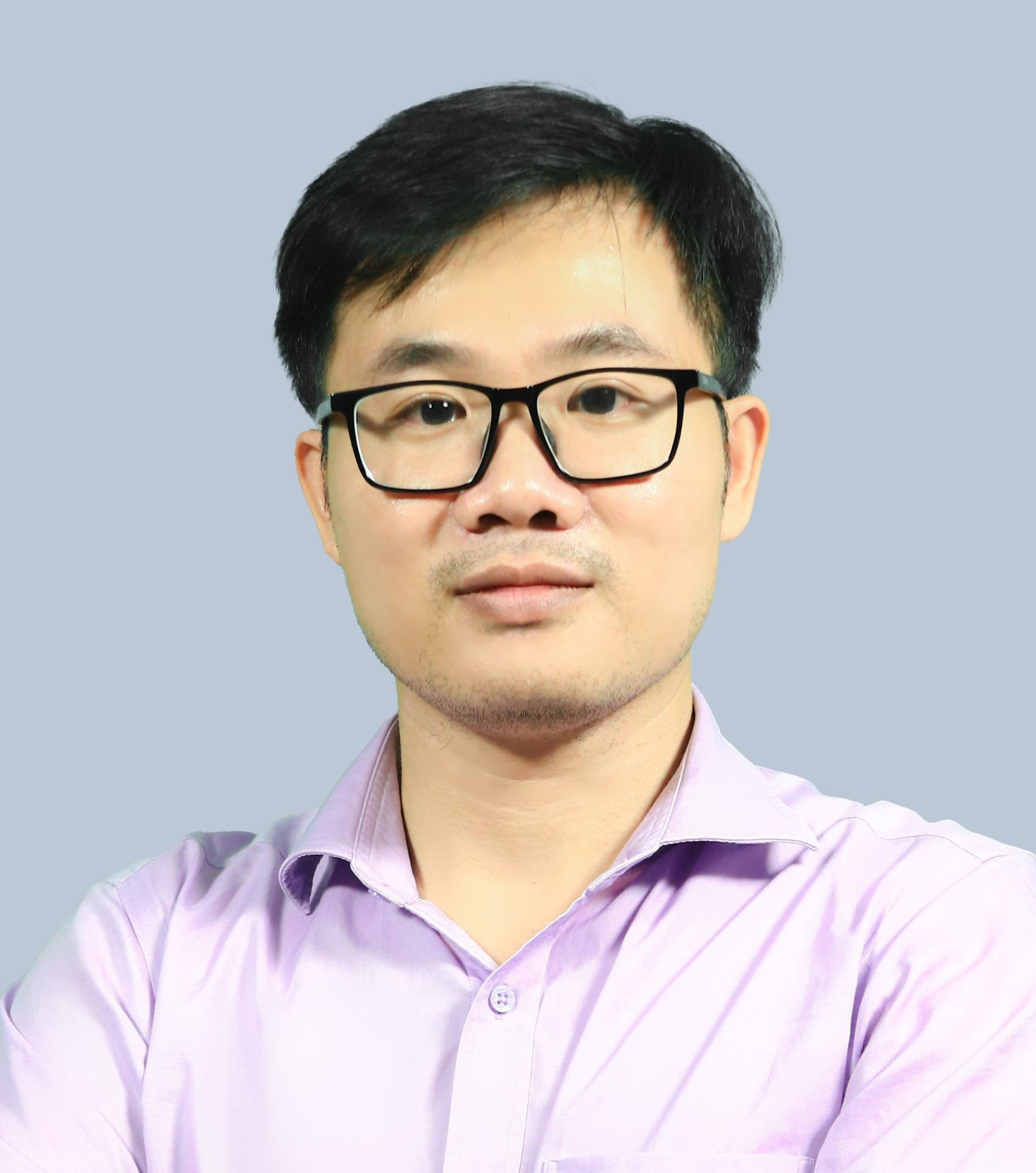
-
This study examines the benefits of using cement in the construction of embankments and deep soil-mixed walls. Soil cement improves stability when used as backfill behind sheet piles and when combined with H-piles in deep soil-mixed walls to reduce horizontal displacement. The shear strength of the soil cement and the interface shear strength between soil cement and steel are critical factors. Laboratory tests were conducted to determine the shear strength and interface shear strength of cement-treated soil under consolidated and drained conditions. The tests considered variables such as effective normal stress, cement content, and curing period. Results showed that increasing the cement content significantly enhanced the effective shear strength and interface shear strength. This improvement was primarily attributed to an increase in the effective friction angle, which was approximately 1.9 and 1.6 times higher for shear strength and interface shear strength, respectively, with 10% cement content. Cohesion remained relatively unchanged. The increase in shear strength and interface shear strength was due to larger grain size and a higher proportion of sand-sized particles in the treated soil. After 28 days, the 10% cement ratio exhibited approximately four times greater improvement. The study also evaluated the brittle behavior of cement-treated soil under high shear deformation by determining peak and residual values of shear strength and interface shear strength. Additionally, the effects of the curing period were assessed using a strength development ratio, and an equation with a high correlation coefficient was proposed to predict the strength development ratio.
10:45-11:45
- Open discussion wth Lecturer Chien
13:00-14:30
- Guest speaker 4
- Datu Buyung AGUSDINATA (Assistant Professor, Arizona State University, USA)
"Sustainability of Critical Minerals: Implications for Clean Technologies and Sustainable Development"
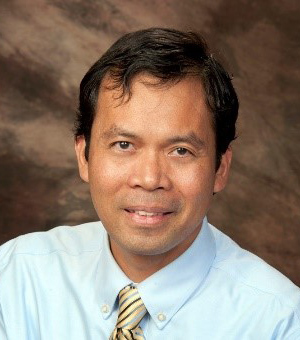
-
The transition to a low-carbon economy, necessary to combat climate change, depends on the availability of critical minerals such as lithium, nickel, copper, and rare earths. However, the increased demand for these minerals due to the adoption of clean technologies like electric vehicles, batteries, wind turbines, and solar panels can inadvertently lead to adverse effects on water resources, biodiversity, and societal well-being in the areas where they are extracted. Finding a solution to sustainability challenges in one area while avoiding the creation of problems in another presents a significant dilemma. In order to address this question, the lecture will shed light on pertinent research findings and agenda. To frame this complex issue, the lecture will employ a telecoupling framework, which examines the intricate causal networks and influences that connect distant social-ecological-technical systems. Through the presentation of various case studies, the lecture will highlight the dynamics of socio-environmental impacts resulting from critical mineral extractions. Moreover, it will explore the potential and challenges associated with advancing the sustainable provision of critical minerals, aiming to facilitate the adoption of low-carbon technologies and the achievement of Sustainable Development Goals (SDGs).
14:45-15:45
- Open discussion wth Assist. Prof. Datu
September 8 (Friday)
09:00-10:00
- Guest speaker 5
- Hajime OHNO (Assistant Professor, Tohoku University, Japan)
"Toward the development of carbon circulation with plastic recycling"
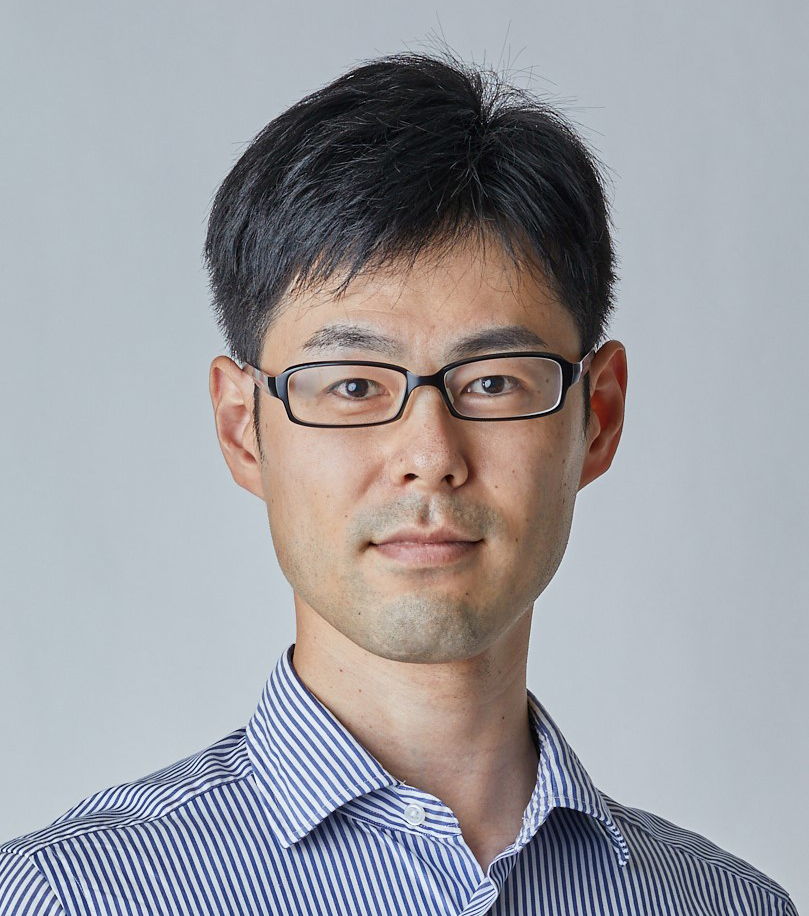
-
Renewable resource utilization is vital for achieving net-zero GHG emissions and phasing out fossil fuels. Chemical industries must shift from using naphtha derived from fossil fuels to obtaining feedstocks from biomass, wastes, and captured CO2. Plastics, as a major waste stream, should be targeted for feedstock recovery. The current mechanical recycling (MR) process has limitations due to the high-quality requirements for waste plastics, resulting in significant waste being burned for energy recovery (ER). This restricts the carbon loop and causes carbon dissipation. By 2050, a carbon circulation system must be established to achieve net-zero emissions. Implementing chemical recycling (CR) alongside MR can minimize ER reliance and establish a robust carbon loop. Accelerating CR technology development and implementation is crucial for this purpose. However, the implementation of CR still faces challenges. During the technology development phase, there is often a focus on obtaining oil with specific properties, which leads to a requirement for high-purity resin. This emphasis on purity conflicts with the objectives of MR. Additionally, in many cases, sorting is not given enough attention during the technology assessment phase. Furthermore, CR is often compared to MR, but it is not a competitor of CR. We must complementarily utilize both MR and CR. Thus, the direction of CR development seems inconsistent with the desired circulation goals. To address these challenges, we are conducting various approaches to developing an effective and sustainable plastic recycling system. Some of our research activities on this topic will be shared in the talk.
10:10-11:40
- Guest speaker 6
- Takahiro YOSHIDA (Assistant Professor, the University of Tokyo, Japan)
"Data-driven Approaches for Climate Change Mitigation and Adaptation"
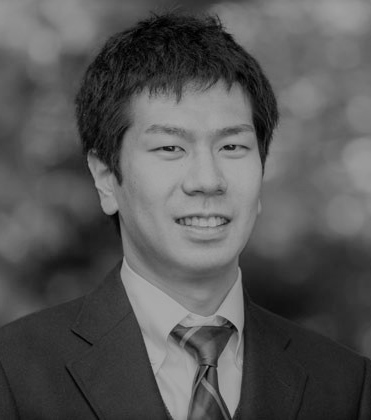
-
For making future communities more decarbonized and climate resilient in the IoT (internet of things) era, I highlight the importance of data-driven approaches. As climate change advances, there are growing interests in managing CO2 emissions at the urban and regional level. One of the main reasons for the importance of "urban" climate change measures is that most of the global CO2 emissions originate from cities. The first step in achieving carbon neutrality in cities is to understand the current situation. It is important to understand temporal and spatial trends in detail in order to consider how to respond through urban development. Urban carbon mapping is a visualization method of CO2 emissions per individual building/street unit and per hourly time unit. In this presentation, I introduce urban carbon mapping and discuss its use and considerations for urban development strategies.
13:00-14:30
- Guest speaker 7
- Benjamin C MCLELLAN (Professor, Kyoto University, Japan)
"A Just Zero Carbon Transition – What Does it Mean for Energy and Resources?"

-
While the world needs to move towards a zero carbon future, the timing, geospatial and socio-economic distribution of impacts and benefits and environmental implications need further investigation. While we all benefit from a reduction in greenhouse gas emissions, many associated benefits such as the local pollutant emissions, will be felt only by some parts of the community. Alternatively, certain sections of the population will be omitted from the benefits due to economic inequalities. This lecture will highlight some of the impacts and benefits from a sustainability perspective up and down the supply chain of energy and its technologies, including the extraction of critical minerals.
14:45-15:45
- Open discussion wth Prof. McLellan
16:00-16:10
- Closing remarks
- Masanobu KAMITAKAHARA (IESLP-WG Head, Professor, GSES, Tohoku University, Japan)
